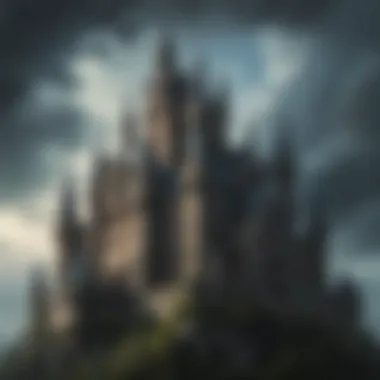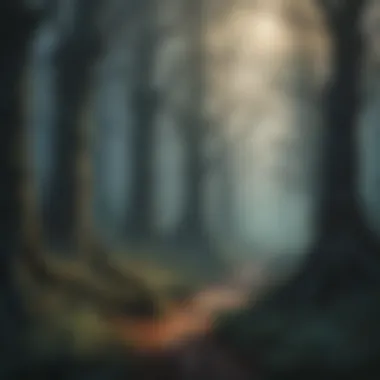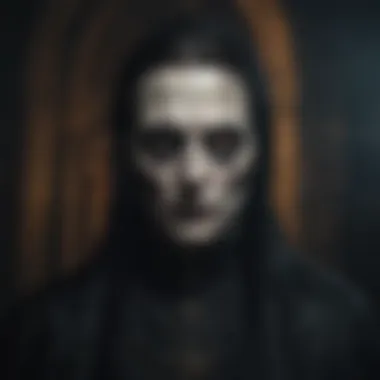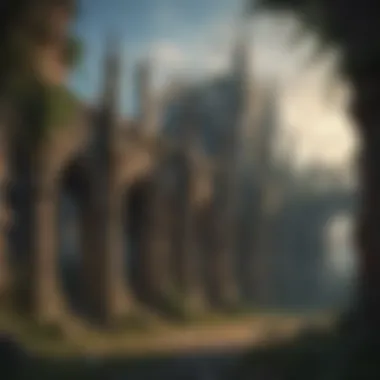Unveiling the Enigmatic Influence of Gothic Elements in Literature


Interactive Learning Games
Educational Topics
As we navigate through the depths of Gothic literature, it becomes evident how themes of darkness, mystery, and psychological exploration have left an indelible mark on the literary world. By understanding these influences, readers can appreciate the nuanced developments that have occurred within literature over time. The importance of interdisciplinary learning surfaces as we connect the dots between Gothic elements and their impact on various subjects like math, science, languages, and more.
Tips and Tricks
Within the labyrinth of Gothic literature lies a wealth of valuable insights that can be extrapolated to enhance children's learning journeys. Practical tips for parents and educators emerge as we draw parallels between Gothic elements and strategies for making learning both fun and engaging. It is through this lens that we glimpse new ways to ignite curiosity and bolster educational experiences.
Creative DIY Projects
Exploring the Gothic influence in literature unveils a world of creativity waiting to be unleashed. Step-by-step guides illuminate the path forward, offering detailed instructions for engaging DIY projects that promote creativity. Within these projects lie the benefits of hands-on activities, nurturing children's cognitive and motor skills with every stroke of their artistic expression.
Introduction
Gothic literature is a captivating realm that has left an indelible mark on the literary landscape throughout the centuries. This article aims to explore the profound influence of gothic elements in literature, delving into the dark, mysterious, and psychologically intricate themes that have shaped literary works in profound ways. By uncovering the connections between darkness, mystery, and the human psyche, this exploration sheds light on how these elements have impacted and sculpted the fabric of literature.
Definition of Gothic Literature
Gothic literature, with its origins dating back to the 18th century, embodies a unique combination of elements that set it apart from other genres. The origins of gothic literature can be traced to the tumultuous societal shifts and the Enlightenment period, where authors sought to challenge cultural norms through their writing. This rebellious spirit is a key characteristic of gothic literature, as it provides a platform for exploring themes of rebellion, the supernatural, and the macabre.
In terms of key characteristics, gothic literature often features a dark, foreboding atmosphere, intricate plotlines filled with suspense, and morally ambiguous characters. These characteristics serve to create a sense of impending doom and unease for the reader, drawing them deeper into the narratives crafted by gothic authors.


Evolution of Gothic Themes
One of the core themes in gothic literature is the exploration of fear and terror. Authors use these elements to evoke a sense of dread and suspense in their audiences, playing on primal human emotions to create gripping narratives. The portrayal of fear and terror adds depth to gothic works, allowing readers to immerse themselves in the dark and chilling atmospheres created by gothic writers.
Additionally, the portrayal of the supernatural is another prominent theme in gothic literature. By blending the natural with the supernatural, authors introduce elements of the unknown and the mysterious into their works, further heightening the sense of mystery and intrigue for readers. This combination serves to create a unique reading experience that delves into the realms beyond the ordinary, inviting readers to explore the boundaries of the human imagination.
Gothic Elements in Literary Works
As we venture into the realm of Gothic literature, the significance of Gothic elements in literary works emerges as a key focal point in this comprehensive exploration. Gothic elements, characterized by darkness, mystery, and elements of the supernatural, play a pivotal role in shaping the narrative landscape of various literary masterpieces. By delving deep into specific elements such as eerie settings, complex characterizations, and macabre themes, this article unveils the intrinsic allure and enduring impact of Gothic elements on literature.
Role of Setting in Gothic Literature
Haunting Architectural Landscapes
The haunting architectural landscapes in Gothic literature provide a palpable sense of unease and foreboding, adding depth and atmosphere to the narrative. These settings, often characterized by dilapidated castles, desolate mansions, and eerie catacombs, serve as integral components that enhance the overall Gothic experience. By immersing readers in these gothic architectural settings, authors create a sense of Gothic ambiance that evokes feelings of dread and mystery. The unique feature of haunting architectural landscapes lies in their ability to set the stage for dark and ominous events, establishing a foreboding tone that lingers throughout the story.
Isolated and Foreboding Terrains
The use of isolated and foreboding terrains in Gothic literature contributes to the sense of isolation and confinement experienced by characters within the narrative. Whether it be desolate moors, labyrinthine forests, or remote mountain ranges, these terrains epitomize a sense of psychological entrapment and heightened tension. The key characteristic of isolated and foreboding terrains lies in their ability to mirror the inner turmoil and isolation of the characters, intensifying the overarching themes of fear and suspense. While offering a sense of escapism, these terrains also present challenges in terms of character development and plot progression, adding layers of complexity to the Gothic narrative.
Characterization in Gothic Fiction
Complex and Morally Ambiguous Characters


The portrayal of complex and morally ambiguous characters in Gothic fiction contributes to the depth and intricacy of the narrative, blurring the lines between hero and villain. These characters, characterized by inner conflicts, secrets, and questionable motives, add a layer of psychological depth and moral ambiguity to the story. By exploring the complexities of human nature through these characters, authors delve into the darker aspects of the psyche, challenging traditional notions of good and evil. The unique feature of complex and morally ambiguous characters lies in their ability to provoke reflection and introspection, compelling readers to grapple with ethical dilemmas and moral ambiguities.
Exploration of Psychological Depths
The exploration of psychological depths in Gothic fiction delves into the inner workings of the human mind, unraveling fears, desires, and obsessions that lurk beneath the surface. Through intricate character analyses and psychological unraveling, authors navigate the complex terrain of human emotions and motivations, shedding light on the shadows that haunt the psyche. The key characteristic of exploring psychological depths lies in its ability to unearth buried traumas, repressed memories, and subconscious desires, adding layers of complexity and depth to the narrative. While enriching the storytelling experience, this aspect of characterization also presents challenges in terms of emotional intensity and psychological realism, demanding a nuanced approach to character development.
Themes of Death and Decay
Symbolism of Mortality
The symbolism of mortality in Gothic literature serves as a powerful motif that underscores the transient nature of life and the inevitability of death. Through symbols such as gravestones, crypts, and spectral apparitions, authors convey the themes of mortality, decay, and the fragility of human existence. The key characteristic of symbolism of mortality lies in its ability to evoke existential ponderings and contemplations on the ephemeral nature of life. By employing symbolic imagery related to death and decay, Gothic writers imbue their narratives with a haunting sense of mortality, imbued with philosophical nuances and existential insights.
Decrepitude and Macabre Imagery
The depiction of decrepitude and macabre imagery in Gothic literature evokes a sense of morbidity and decay, enhancing the atmosphere of gloom and doom within the narrative. From decaying mansions to desecrated tombs, these macabre images symbolize the passage of time, the inevitability of decay, and the inescapable grasp of mortality. The unique feature of decrepitude and macabre imagery lies in its ability to instill a sense of foreboding and unease, casting a shadow of morbidity over the narrative landscape. While creating a macabre aesthetic, this thematic element also serves as a reflection of the characters' inner turmoil, highlighting the themes of mortality, decay, and the darker aspects of human nature.
Influence of Gothic Literature
When delving into the intricate realm of literature, one cannot ignore the profound impact that Gothic elements have had on shaping various literary works throughout history. Gothic literature is a genre characterized by dark themes, mysterious settings, and exploration of the human psyche's depths, which have resonated with readers for centuries. In this article, we aim to dissect and unravel the influence of Gothic literature on the broader literary landscape, providing a comprehensive analysis of its significance and enduring relevance.
Impact on Subsequent Literary Movements
Romanticism and Victorian Literature


Exploring the interconnectedness between Gothic literature and subsequent literary movements such as Romanticism and Victorian Literature unveils a rich tapestry of influence and inspiration. Romanticism, with its emphasis on emotion, nature, and individuality, drew heavily from the dark, atmospheric settings and intense emotions often found in Gothic fiction. The Victorian era further refined these Gothic elements by integrating moral complexities and social critiques into the narrative, deeply impacting the thematic undercurrents of literature. By dissecting the key characteristics of Romanticism and Victorian Literature within the context of Gothic influence, we can appreciate how these movements continue to shape our understanding of literary expression.
Modern Gothic Revivals
In the contemporary literary landscape, Modern Gothic Revivals have resurfaced, breathing new life into age-old tropes and themes of Gothic literature. These revivals reimagine traditional Gothic elements through a modern lens, blending traditional darkness with innovative storytelling techniques and societal reflections. The resurgence of Gothic aesthetics in modern literature not only pays homage to the genre's rich legacy but also offers a platform for exploring new avenues of psychological depth and cultural critique. By examining the unique features of Modern Gothic Revivals and their impact on Gothic literature's influence, we gain insight into how the genre continues to evolve and captivate audiences across generations.
Contemporary Interpretations of Gothic
In this insightful section of the article, we delve into the contemporary interpretations of Gothic literature, shedding light on its enduring relevance in modern times. As literature continually evolves, the exploration of how Gothic elements manifest in contemporary settings becomes paramount. We navigate through the intricate web of darkness and mystery, seeking to understand how these themes resonate with today's audiences. By examining the influence of Gothic literature on current narrative forms, we gain a deeper appreciation for its timeless allure.
Gothic Influences in Popular Culture
Gothic Elements in Film and Television
Delving into the realm of Gothic elements in film and television unlocks a treasure trove of visual storytelling infused with dark and eerie undertones. From haunting set designs to morally complex characters, Gothic elements infuse these mediums with a sense of mystery and suspense. The use of shadows and darkness adds depth to the narrative, creating a haunting atmosphere that captivates viewers. This exploration highlights the evolution of Gothic themes within the context of visual storytelling and the enduring popularity of these elements in captivating audiences.
Gothic Tropes in Literature
The exploration of Gothic tropes in literature unveils a rich tapestry of narratives steeped in macabre themes and psychological depth. By delving into archetypal characters and eerie settings, Gothic tropes create a sense of unease and foreboding that resonates with readers. These elements serve as a foundation for building tension and suspense within literary works, offering a unique lens through which authors can explore complex themes such as mortality and decay. The enduring popularity of Gothic tropes in literature speaks to their profound impact on shaping storytelling traditions and engaging audiences.
Relevance of Gothic in the Digital Age
In examining the relevance of Gothic literature in the digital age, we uncover how traditional themes find new expression through virtual hauntings and Gothic gaming. By immersing audiences in interactive narratives infused with Gothic elements, creators blur the lines between reality and fiction, inviting participants to explore haunted worlds from the comfort of their screens. This innovative approach to storytelling offers a fresh perspective on Gothic themes, leveraging technology to enhance the immersive experience for modern audiences.
Virtual Hauntings and Gothic Gaming
The realm of virtual hauntings and Gothic gaming provides a platform for audiences to engage actively with Gothic elements, immersing themselves in eerie landscapes and supernatural encounters. By incorporating elements of fear and suspense into interactive gameplay, creators evoke a sense of unease and excitement, drawing players into a world where darkness reigns supreme. The unique blend of storytelling and gameplay mechanics in virtual hauntings and Gothic gaming offers a fresh take on Gothic literature, inviting players to confront their fears and unravel mysteries in an interactive digital landscape.
Online Gothic Communities
Online Gothic communities serve as digital havens for enthusiasts to connect, share, and explore all things Gothic. From discussions on classic Gothic literature to modern interpretations of the genre, these online spaces provide a platform for like-minded individuals to converge and engage in spirited debates. The benefits of online Gothic communities lie in their ability to foster a sense of camaraderie among fans, creating a virtual niche where Gothic culture thrives. While these communities offer a vibrant space for Gothic aficionados to interact, they also pose the challenge of maintaining a balance between inclusivity and authenticity, ensuring that the essence of Gothic literature is preserved in online discourse.















